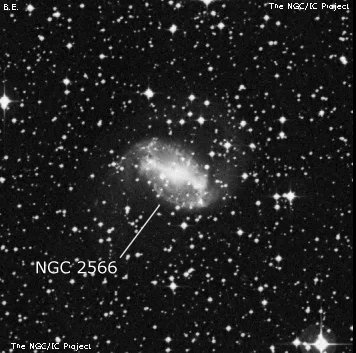
William Herschel discovered NGC 2566 = H III-288 on 6 Mar 1785 (sweep 381) and recorded "vF, considerably large, easily resolvable or rather some of the stars visible besides those of the milky way scattered over it." His position is off the north side of the galaxy. Herbert Howe described the galaxy as a "vS neb or neb *11 w/*12 close". Pietro Baracchi described this object as "vF; pL; 2 stars 14m involved. A multititude of stars in the field." (9 Jan 1886, 48" Melbourne). Visually, nearby IC 2311 has a higher surface brightness and is more identifiable as a galaxy!
400/500mm - 17.5" (3/25/95): faint, fairly large, elongated 3:2 ~ENE-WSW, 2.5'x1.8', diffuse, edges fade into background. Unconcentrated except for a nearly stellar bright core. Unusual appearance (similar to a Milky Way nebula) as it is located in a dense field among a rich group of faint stars including a mag 13 star just following the nucleus. A 10' semicircle of stars heads to the north and west. Forms a pair with IC 2311 7.6' N. The IC galaxy appeared fairly faint, fairly small, round, 1.2' diameter. Even concentration to a small bright core and stellar nucleus. NGC 2566 is the brightest member of the Klemola 10 quartet.
17.5" (3/7/92): faint, fairly large, elongated 3:2 E-W, ~2.0'x1.5', very low even surface brightness. There is no core and the outer halo is not well defined. Several stars are superimposed including a mag 13.5 star 22" ESE of center. Situated in a rich Milky Way field. Brightest in a group including IC 2311 7.6' N. Located just 6° from the galactic equator.
Notes by Steve Gottlieb